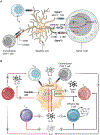Architects of immunity: How dendritic cells shape CD8+ T cell fate in cancer
- PMID: 39823318
- PMCID: PMC11970844
- DOI: 10.1126/sciimmunol.adf4726
Architects of immunity: How dendritic cells shape CD8+ T cell fate in cancer
Abstract
Immune responses against cancer are dominated by T cell exhaustion and dysfunction. Recent advances have underscored the critical role of early priming interactions in establishing T cell fates. In this review, we explore the importance of dendritic cell (DC) signals in specifying CD8+ T cell fates in cancer, drawing on insights from acute and chronic viral infection models. We highlight the role of DCs in lymph nodes and tumors in maintaining stem-like CD8+ T cells, which are critical for durable antitumor immune responses. Understanding how CD8+ T cell fates are determined will enable the rational design of immunotherapies, particularly therapeutic cancer vaccines, that can modulate DC-T cell interactions to generate beneficial CD8+ T cell fates.
Conflict of interest statement
Figures



Similar articles
-
Oncolytic immunovirotherapy: finding the tumor antigen needle in the antiviral haystack.Immunotherapy. 2025 Jun;17(8):585-594. doi: 10.1080/1750743X.2025.2513853. Epub 2025 Jun 6. Immunotherapy. 2025. PMID: 40474818 Review.
-
Autologous tumor lysate-loaded dendritic cell vaccination in glioblastoma patients: a systematic review of literature.Clin Transl Oncol. 2025 Jul;27(7):2889-2903. doi: 10.1007/s12094-024-03830-9. Epub 2024 Dec 23. Clin Transl Oncol. 2025. PMID: 39714754
-
Interactions Between the Innate and Adaptive Immune Responses.Adv Exp Med Biol. 2025;1476:297-308. doi: 10.1007/978-3-031-85340-1_12. Adv Exp Med Biol. 2025. PMID: 40622548 Review.
-
Evidence of immunogenic cell death (ICD) and ICD-dependent dendritic cell activation induced by extracorporeal photopheresis in patients with leukaemic forms of cutaneous T-cell lymphoma.Br J Dermatol. 2025 Jul 17;193(2):276-286. doi: 10.1093/bjd/ljaf102. Br J Dermatol. 2025. PMID: 40112181
-
Correction of age-associated defects in dendritic cells enables CD4+ T cells to eradicate tumors.Cell. 2024 Jul 25;187(15):3888-3903.e18. doi: 10.1016/j.cell.2024.05.026. Epub 2024 Jun 12. Cell. 2024. PMID: 38870946 Free PMC article.
Cited by
-
Deciphering the deterministic role of TCR signaling in T cell fate determination.Front Immunol. 2025 May 21;16:1562248. doi: 10.3389/fimmu.2025.1562248. eCollection 2025. Front Immunol. 2025. PMID: 40469304 Free PMC article. Review.
-
Advances and obstacles of T cell-based immunotherapy in gynecological malignancies.Mol Cancer. 2025 Jul 26;24(1):207. doi: 10.1186/s12943-025-02411-w. Mol Cancer. 2025. PMID: 40713697 Free PMC article. Review.
-
Crucial meeting: molecule helps vaccine to interact with killer T cells.Nature. 2025 May;641(8061):44-46. doi: 10.1038/d41586-025-00900-y. Nature. 2025. PMID: 40140512 No abstract available.
-
Polio virotherapy provokes MDA5 signaling and CD4+ T cell help to mediate cancer in situ vaccination.Microbiol Mol Biol Rev. 2025 Jul 8:e0004024. doi: 10.1128/mmbr.00040-24. Online ahead of print. Microbiol Mol Biol Rev. 2025. PMID: 40626649 Free PMC article. Review.
References
Publication types
MeSH terms
Substances
Grants and funding
LinkOut - more resources
Full Text Sources
Medical
Research Materials

